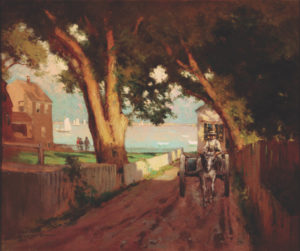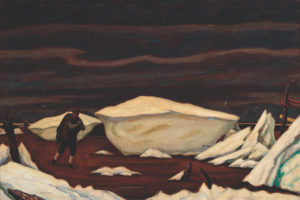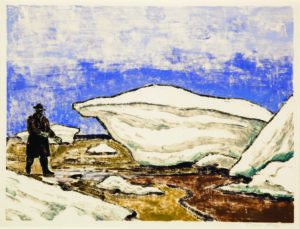Returning to the Provincetown Art Association and Museum, after several months without setting foot in an art museum, feels like coming home: white walls sprinkled with paintings, the sound of slow footsteps on hardwood floors. Though only 10 masked art-lovers are allowed in at a time for one-hour reserved slots during the ongoing Covid-19 crisis, the restriction almost seems fitting — the space feels quieter, more meditative.
PAAM reopened to the public on Saturday, and its two major exhibitions, “In Memoriam: Napi Van Derek” and “Harbor to Bay From the Permanent Collection,” are the perfect way to welcome visitors back into the museum. (The two other exhibits on view are members’ shows, each with hundreds of submitted works: “Members’ Open: Freedom” and “Members’ 12×12 Exhibition and Silent Auction.”)
Both archival shows are undeniably comforting. The Napi Van Derek exhibition, hung in the Jalbert Gallery, consists of works owned by the late art collector and restaurateur, who died last Christmas Day. It depicts old Provincetown through different lenses.

In George Elmer Browne’s Horse and Carriage on Nickerson Street, dated 1902, three background figures gaze onto the waterfront, where sailboats are propelled by a gentle breeze. The illusion of familiarity is shattered by a man in a straw hat driving a horse and buggy, the wheels leaving tracks in the dusty, unpaved road.
“I tried to pick things that were nostalgic,” says Christine McCarthy, the exhibition’s curator and PAAM’s CEO. “You can walk into those Nancy Fergusons like walking down Commercial Street.” She hopes that, especially for those who have been quarantined, the show feels like a stroll through Provincetown.
Moving into the Duffy Gallery, “Harbor to Bay,” also curated by McCarthy, consists of works from PAAM’s vast and storied permanent collection that were inspired by Provincetown’s relationship to the bodies of water that surround it.
There is much variety here in terms of styles and dates. One of best walls has the very atmospheric Provincetown Harbor, Railroad Wharf in the Rain by Edwin Dickinson, alongside the monumental Pilings #4 by Anne Peretz, beside an untitled collage by Janice Biala.
But what is especially brilliant about these two exhibitions is that they are linked by one subtle thread.

In the Napi collection show, on the wall leading into the Duffy gallery, is a painting Ice on Provincetown Harbor by Provincetown social realist Ross Moffett, a prominent student of Charles Webster Hawthorne, dated 1934. In it, a fisherman hauling his gear is dwarfed by a monumental ice floe that stands out white against a purple sky. In the background, another fisherman stands beside a red dory.
“Moffett’s style is so unique with his figures,” McCarthy says. “They take on this Herculean form.” Indeed, Moffett was often inspired by Renaissance frescoes.

Just in the next room, as part of “Harbor to Bay,” is this painting’s twin: a monotype print of the same name, also by Moffett, dated only a year later. The contour of the ice is exactly the same; Moffett appears to have been obsessed with this natural formation, almost like Monet with his haystacks. This time the ice floe overshadows a dark, solitary figure donning gloves and boots. McCarthy says it was not unusual for Moffett to do prints and paintings of the same subject.
According to a March 1934 issue of the New York Times, that year saw an especially icy winter in Provincetown, with reports of the harbor “filled solidly from shore to mouth with closely packed field ice one to four feet thick” as well as anchor ice “piled 10 to 30 feet high.” Mammoth ice floes, though unusual, are not unheard of. “One winter we had icebergs right across the street at Angel Foods,” McCarthy says.
“It is not easy to do a winter scene — they are difficult,” McCarthy says. “Moffett had a unique sensibility about weather and creating a mood.” Josephine Del Deo, in her book Figures in a Landscape, writes, “In the painting Ice in Provincetown Harbor, the fisherman, overwhelmed by the scale of the ice floe, nevertheless seems calmly at ease in his unusual surroundings.”
These works by Moffett, which link the two exhibitions, draw attention to their shared themes. They are about Provincetown as a familiar place, a safe haven, a harbor or bay protected from the wildness of the sea. And indeed, going to PAAM after all of these months feels like coming into harbor.
